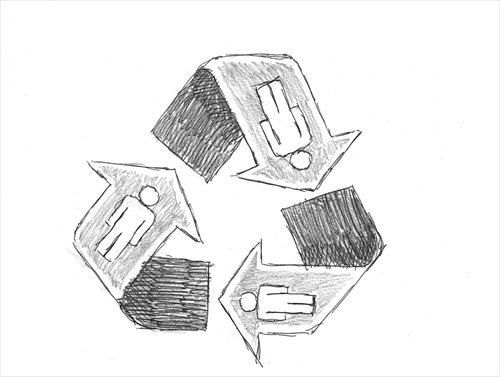HOME >> BUSINESS
Solution to unemployment starts with SOE flexibility
Source:Global Times Published: 2016/6/16 0:28:00

Illustration: Peter C. Espina /GT
In a recent inspection tour in East China's Anhui Province, Chinese President Xi Jinping stressed that a certain level of unemployment is likely to occur under downward economic pressure as supply-side structural reforms push forward. He noted that more emphasis should be placed on creating more job opportunities, implementing and improving assistance measures and helping those who have trouble finding jobs. This suggests that China faces a headwind in domestic employment, both currently and in the foreseeable future.Statistics from the China Institute for Employment Research (CIER), which regularly publishes the CIER index analyzing China's employment and market situation based on activity on major online recruitment platform Zhaopin, have shown that China's overall employment market has been cooling down. Meanwhile, the CIER index - which reflects the ratio of vacant positions divided by total applicants - has continued to decline, with the reading remaining significantly lower than that of last year, especially during the first quarter of 2016. But the March 2016 registered unemployment rate from the National Bureau of Statistics has been stable at around 5.2 percent.
Structural unemployment is believed to be the root cause of this statistical difference. On one hand, traditional manufacturing - especially industries with excess capacity - is under pressure to lay off particular groups of employees or redirect lay-offs to other positions to the tune of an estimated 6 million or 7 million workers. On the other hand, China's service industry is facing tremendous difficulty recruiting certain kinds of laborers. In addition, as a result of China's long-established family planning policy and the gradual return of some migrant workers from big cities to jobs in their hometowns, China's overall labor supply has dropped sharply.
Furthermore, CIER Director Zeng Xiangquan has also noted that China faces a comparatively serious problem of recessive unemployment. Some State-owned enterprises (SOEs) are indeed afflicted with low efficiency, unsatisfactory business performance and the burden of personnel redundancies, but certain inherent characteristics of the SOEs and restrictions in China's Labor Contract Law have forced those SOEs to squeeze salaries instead of cutting jobs. This has created situations in which some enterprises pay only basic wages, leading to reduced working hours and reduced employment quality.
In fact, compared to the country's social security system, China's SOEs have shouldered a large part of the responsibility to ensure that employees' standard of living is above the minimum threshold. If these enterprises become unable to continue operating, the subsequent accommodation and reemployment of workers must depend on social forces. Even though the country has issued a series of policies and measures, many local governments that ought to shoulder the responsibility of providing channels to encourage employment don't seem to be well prepared.
In fact, a large number of job opportunities exist in China's service sector, particularly the nursing industry, which has the potential to offer several millions of jobs. Caregivers who are equipped with excellent medical care skills, an understanding of senior citizens' psychological characteristics and abundant social knowledge are warmly welcomed in the labor market and usually receive much higher salaries than the national average. Sadly, China's relevant vocational training is extremely lacking, while many young Chinese don't view nursing and care-giving as valuable and are reluctant to endure the hardships that such jobs require. This has left China's nursing industry at a low level of development that has failed to absorb strong employment.
Many local governments and financial institutions have also given too much protection to less efficient SOEs, especially zombie enterprises. This has not only led to the accumulation of economic risks, but has also hindered progress in the arrangement of lay-offs. This situation requires local governments to urgently break the pattern by offering more effective services and measures to support re-employment. Meanwhile, those who are laid off, especially from SOEs, should abandon the traditional notion of the "iron rice bowl," which offers jobs for life. Only through joint efforts can China gradually reduce the potential risk of mass unemployment and ensure that the pain caused by economic transition can be as low as possible. Without marked improvement in the above aspects, it's not safe to conclude that China's employment situation is improving.
In addition, we should note that smaller businesses in China have become another channel to absorb employment. The CIER report's statistics show that during the first quarter of 2016, labor demand from China's small businesses - which range in scale from 20 to 99 people - has grown by 14 percent, year-on-year, faster than the national average of 4 percent. Meanwhile, labor absorbed by micro businesses, which employ less than 20 people, has grown by 22 percent, year-on-year. Local governments thus face a big challenge in improving the operational environment for such businesses while helping them expand their competitiveness so as to achieve the goal of creating more jobs.
The article is based on a report by Beijing-based private strategic think tank Anbound. bizopinion@globaltimes.com.cn
Posted in: Expert assessment